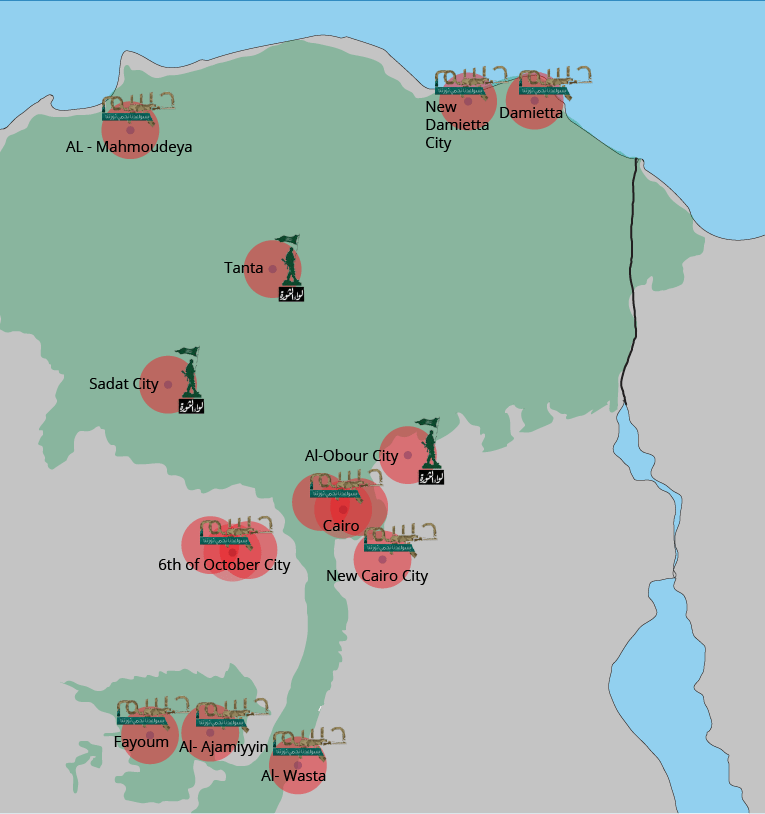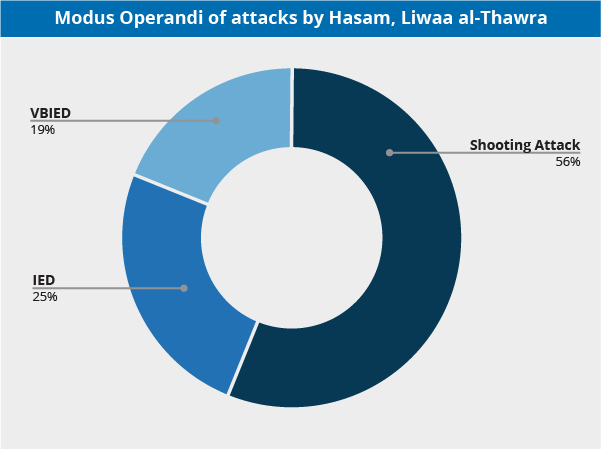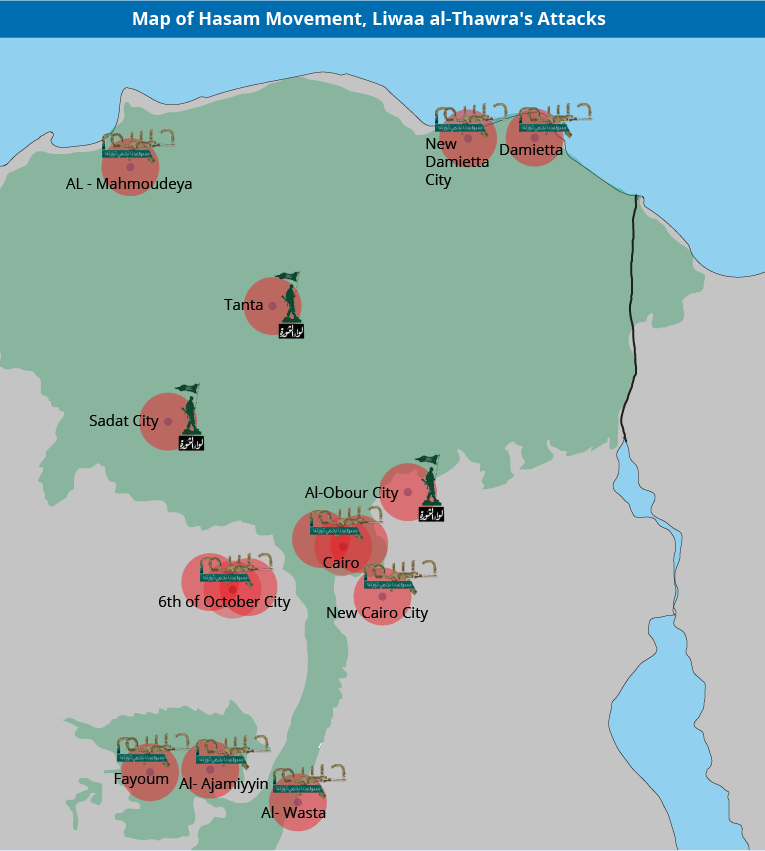Executive Summary:
Of the several militant groups that operate in mainland Egypt, the two most active ones currently are the Hasam Movement and Liwaa al-Thawra, both composed of disenfranchised Muslim Brotherhood elements.
While these are overtly two separate entities, there are many similarities between the groups that point to a joint origin, as well as possibly ongoing cooperation.
Regardless, both groups proved to be of high and growing capabilities, and are thus likely to attempt to continually expand their operations throughout mainland Egypt and conduct more sophisticated attacks targeting governmental locales, individuals perceived to be associated with the government, as well as security forces.
Travel to Cairo and Alexandria may continue while adhering to all security precautions regarding militancy and civil unrest. Consult with us for itinerary-based travel recommendations.
Ideology & Goals of Disenfranchised Muslim Brotherhood Groups
Both the Hasam Movement and Liwaa al-Thawra subscribe in essence to the ideology of the Muslim Brotherhood, and set as an objective to remove the “regime of the military coup” and replace it with what they perceive as the democratically elected and legitimate Muslim Brotherhood-led government, similar to the model of the June 2012-July 2013 government.
However, one distinct difference between these groups and the current official Muslim Brotherhood leadership is the approach towards the application of violence. While the official stance of the current leadership of the Brotherhood movement is that it should be a “peaceful and democratic organization”, the approach of the militant groups is to sanction measured violence in the context of achieving the political movement’s overall objectives.
In this context, while given the organizations’ structures and their opaqueness, the characteristics of the relationship between the Muslim Brotherhood and the militant groups remain unclear, there are two likely possibilities, which are not necessarily mutually exclusive.
First, the dichotomy could be a manifestation of an internal struggle between an “old guard” that adheres to the guidelines of avoiding the use of deadly force, and a “new guard” that grew frustrated with the perceived inability to achieve the political goals strictly using non-violent means, prompting it to change strategies.
The second option is that the disconnect between the political movement and the various militant groups is maintained at an overt level only, in order to avoid causing a delegitimization of the whole Muslim Brotherhood movement. However, in this scenario, there would be at least a limited covert direct communication and subordination system. Should this be the case, it would mean that the entities in effect serve as a political and military wing of the organization, even if this structure is only accepted by parts of the overall movement.
Strategy & Evolution
As a result of this, the groups are less likely to target Westerners, Western institutes and strategic facilities. The main reason for this is that their vision is to ultimately restore complete control over Egypt while causing as little damage to its infrastructure and core as possible, as they will need these elements, along with foreign tourism and investment, to more easily govern the state in the future. That said, it cannot be ruled out that the radicalization process that caused their creation will persist should the groups fail to reach their objectives, prompting them to conduct high profile attacks and attacks against soft targets out of desperation, however this remains a remote possibility at this time. Nonetheless, despite currently discreetly targeting state actors and attempting to avoid civilian casualties, some of the attacks by the groups caused collateral damage, thus indicating that they are willing to accept causing at least limited civilian casualties in order to achieve their goals.
Furthermore, both Hasam and Liwaa al-Thawra’s capabilities were relatively high to start, as shown by their own published videos depicting their training, as well as by their attacks which at times are aimed at high-value targets. This is further indicated by the claims of responsibility for these attacks, depicting mostly advanced surveillance and intelligence collection techniques, as well as tactical proficiency. This itself serves as an indication that members of the group have previous training and experience, which may be due to previous membership in now defunct militant groups, such as Popular Resistance in Giza, Revolutionary Punishment, or even Ajnad Misr. This may also indicate that the groups have attracted former members of the security establishment, who became disillusioned with the state of affairs of post-revolution Egypt, and applied their skills in the ranks of these militant groups.
Additionally, while both groups showed relative high capabilities since inception in July-August 2016, these have continued to progress with time, from very limited scale operations such as assassinations, to larger scale and more sophisticated attacks, such as vehicle-borne IEDs (VBIEDs). While Hasam is the slightly more veteran of the groups, the fact that the development in capabilities of both groups overlapped may serve as an indication of direct cooperation.
Links between Hasam & Liwaa al-Thawra
Videos issued by the respective groups show emphasis on similar tactics and using similar techniques: Assassinations, drive-by shootings, IED making, assembly and activation, firing ranges with small arms fire and shoulder fired rocket launchers, small unit tactics- including combined and coordinated attacks by several small forces.
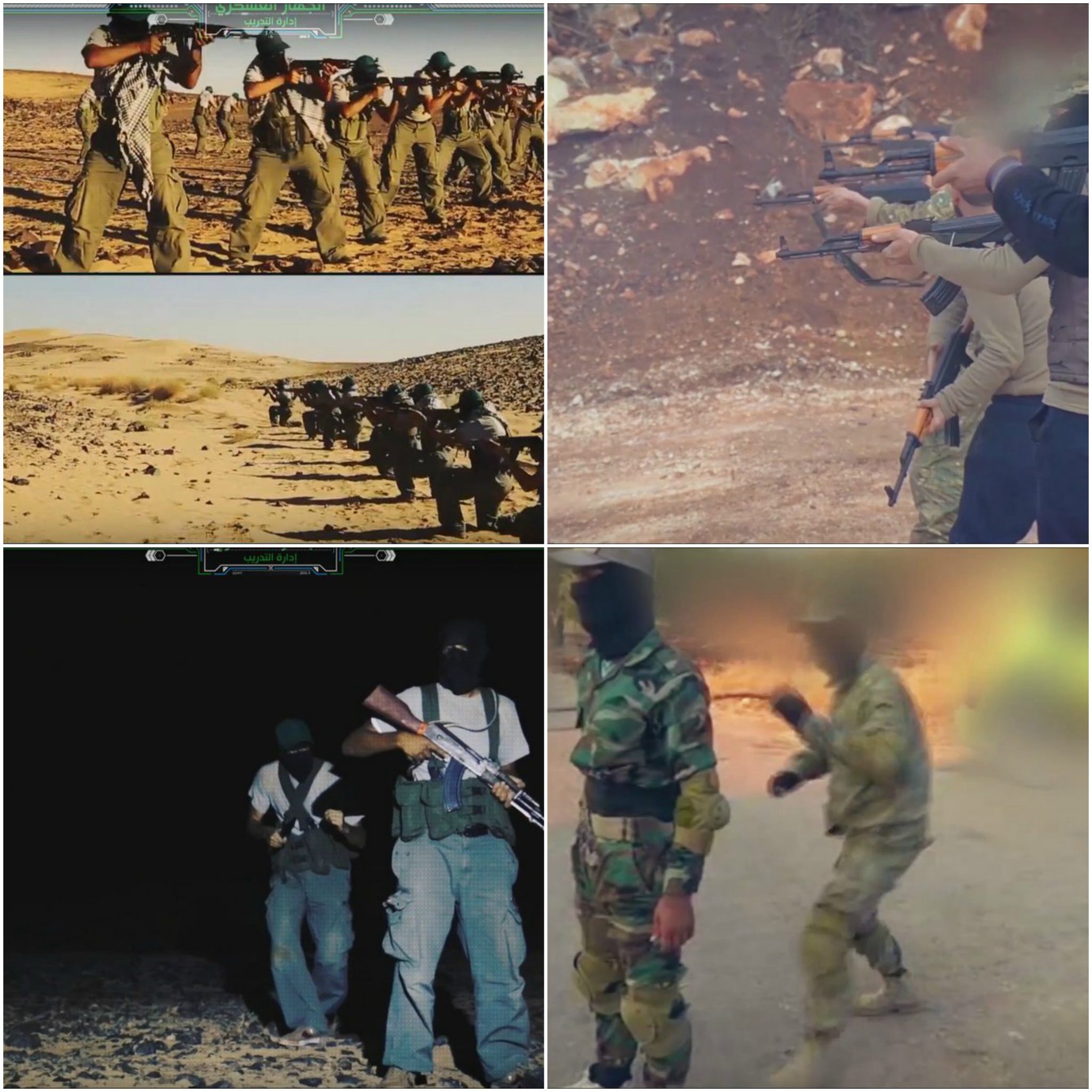
Moreover, and in addition to the aforementioned similarities in modus operandi of the attacks themselves, the claims of responsibility by the respective groups use similar graphics and put an emphasis on the intelligence collection and surveillance element prior to conducting the mission, as well as of the battle damage assessment phase after the attack is conducted.
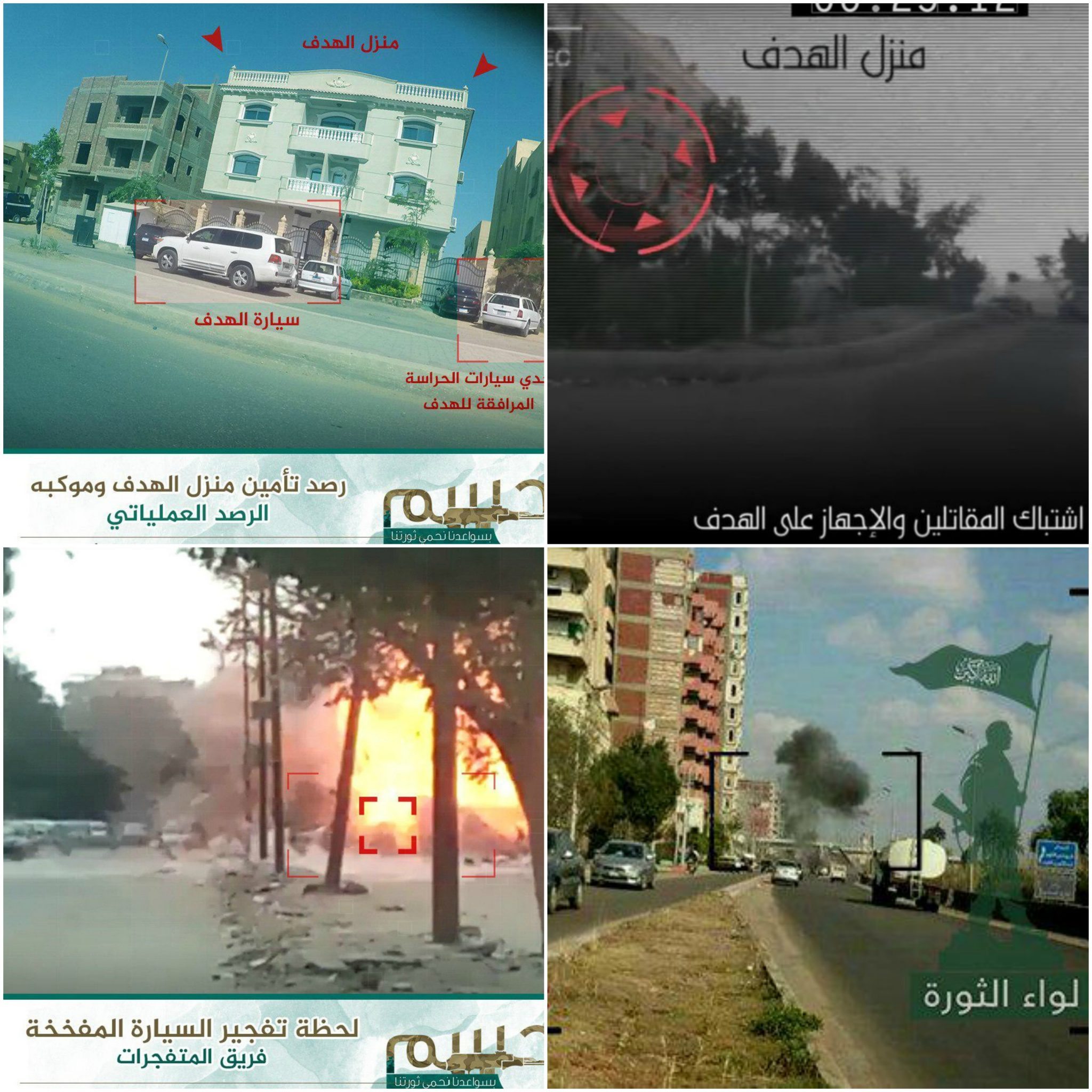
Furthermore, while never issuing a joint statement thus far, following the December 11, 2016 suicide bombing in a Coptic church in Cairo which was later claimed by the Islamic State (IS), both Hasam and Liwaa al-Thawra issued separate statements condemning the attack less than 15 minutes apart. Both statements used similar rhetoric, offering condolences to the victims and their families, stating that targeting “innocent Egyptians” should not be accepted, and that the only legitimate targets are those associated with the “corrupt government”.
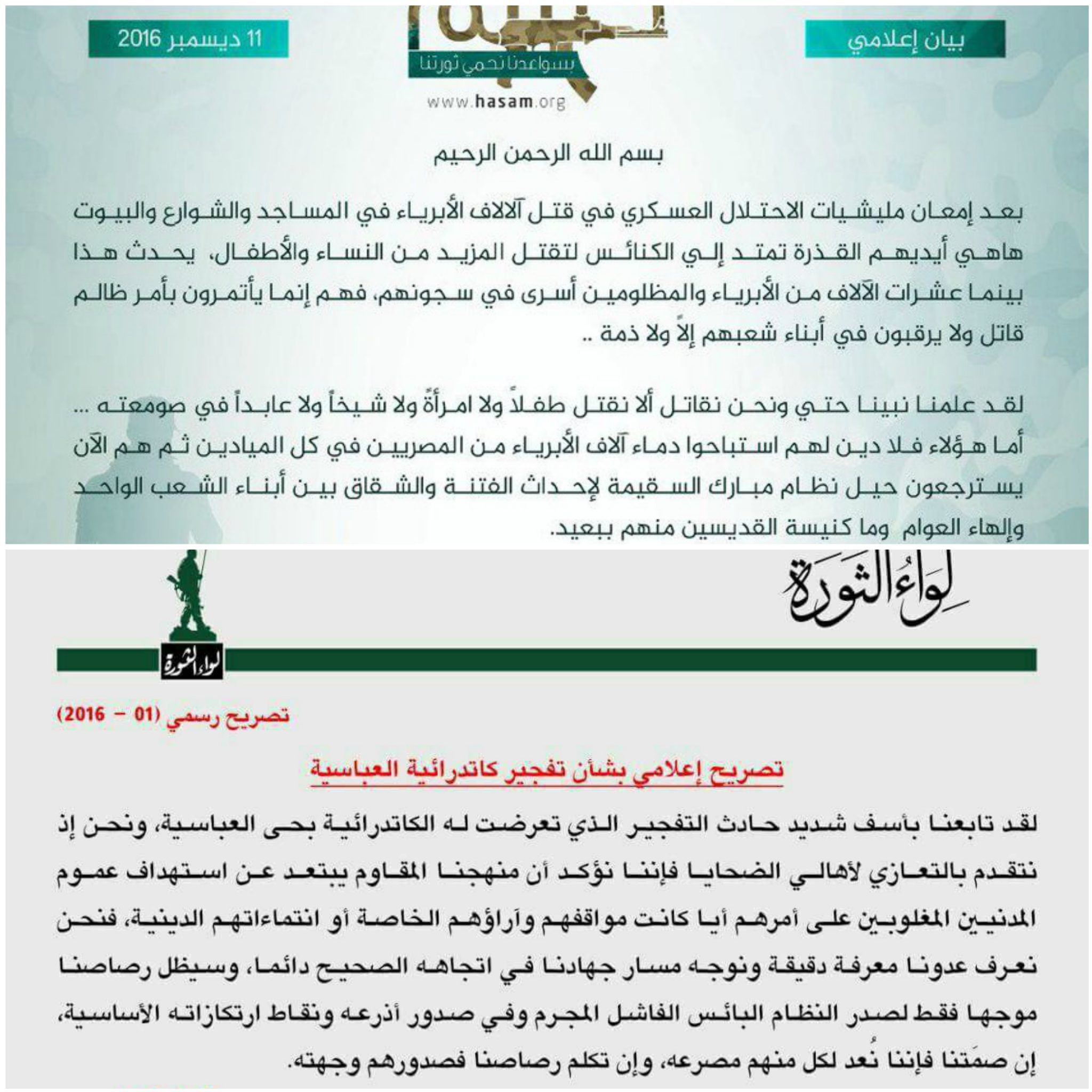
Lastly, following two of the overall three attacks conducted thus far by Liwaa al-Thawra, the Hasam Movement issued congratulatory messages through their official media branch, affirming the positive connections between the groups.
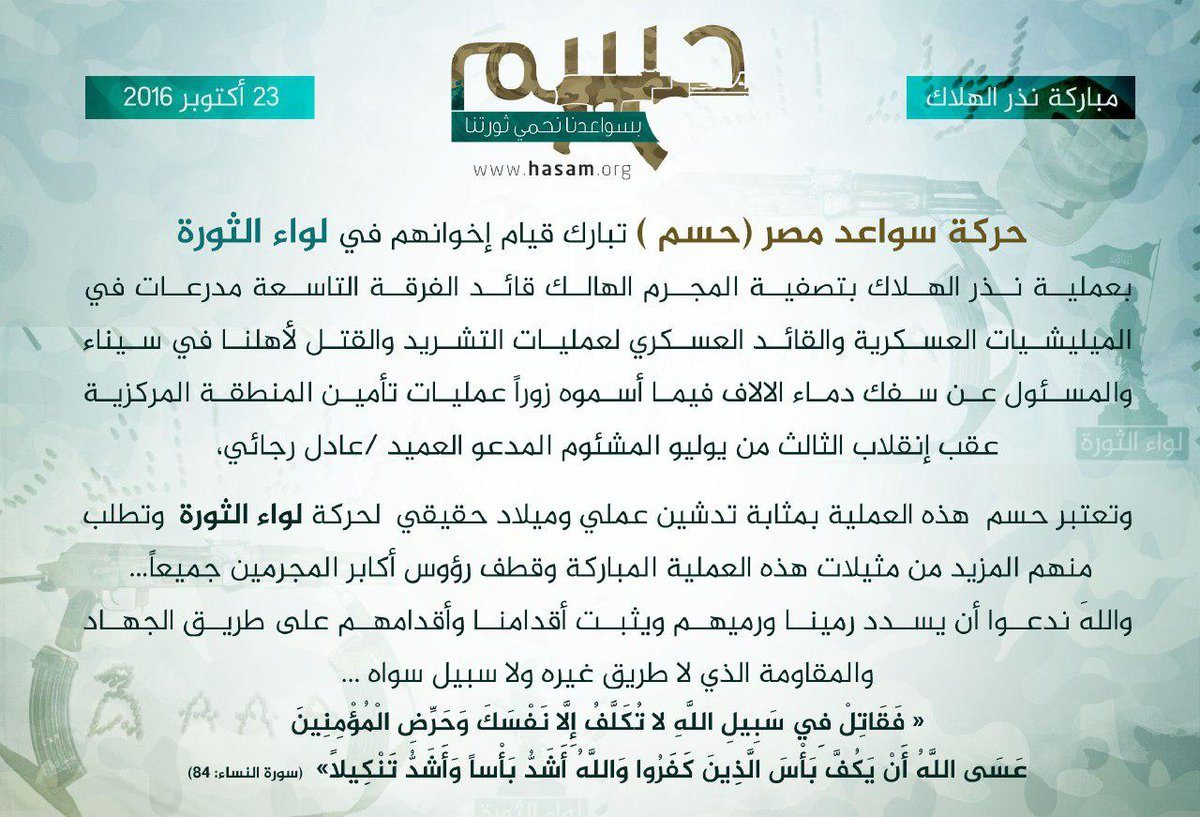
Future Projections
Previous attacks conducted by both of the groups show that they are not constrained to a specific area of the mainland, and have the ability to operate throughout large parts of it. As the respective groups are likely not large, given the still relative low frequency of their attacks, this is a further indication of their operational capabilities. As a result, regional cells are probably dispatched between different locales to attack notable targets, in likely addition to local cells capitalizing on coincidences to attack targets of opportunity which are typically of lesser quality. This would also account for the large number of attacks in and around Cairo, due to the city’s significance and the fact that it offers more quality targets.
The element of survivability had proven to be vital for both groups given their limited sizes and resources. Similarly, the fluctuations in their activities, along with the spread of their operations can also be associated with reducing their profile in order to evade the high intensity security operations waged against both groups. Thus, militants will go into hiding or completely escape the area, wait until immediate ramifications by security forces expire, or will exploit a weakness in their system, and then resume offensive operations.
While such operations witnessed successes, killing militants from both Hasam and Liwaa al-Thawras in actions that were confirmed by the respective groups, the fact that the groups remain operational and even have expanded their operations is a testament to their overall high capabilities. With this in mind, while both groups may alternately limit their operations, particularly given the ongoing nationwide state of emergency, overall they are liable to seek to further expand their operations by conducting more notable attacks against high profile targets over the coming months. While security forces may foil some of these operations, given precedent at least some of these are likely to successful materialize. Furthermore, despite this desire to expand, both Hasam and Liwaa al-Thawra remain small in size and limited in resources, and given their proven experience and proficiency will be cautious of overstretching and overexposing themselves, thus any possible expansion in operation is liable to be measured.
Recommendations
Travel to Cairo and Alexandria may continue while adhering to all security precautions regarding militancy and civil unrest. Consult with us for itinerary-based travel recommendations.
Avoid all travel to the North Sinai Governorate and border areas with Libya, Sudan, and Israel due to the persistent risk for militant attacks, kidnappings, and general lawlessness.
We further advise to avoid nonessential travel to the Southern Sinai Peninsula, while maintaining heightened vigilance in the Suez Canal Zone, the Upper Nile area, and the Nile Delta region due to an increased risk of unrest and the heightened risk of militant attacks. Before traveling to Sharm al-Sheikh, confirm that flight operations are continuing and have not been impacted by recent militant threats.
In Cairo, maintain heightened vigilance and continue to allot extra time for travel due to possible delays emanating from increased security deployments, checkpoints, and closures throughout the capital.
As a general security precaution, remain vigilant in areas surrounding and avoid the immediate vicinity of government installations, police stations, and religious centers, particularly churches, as these locations remain under elevated threat of militant attacks. When traveling in central squares, or in areas with persistent police deployments, avoid the immediate vicinity of security forces, particularly fixed traffic booths, as such personnel and facilities have increasingly come under attack by militant elements.
